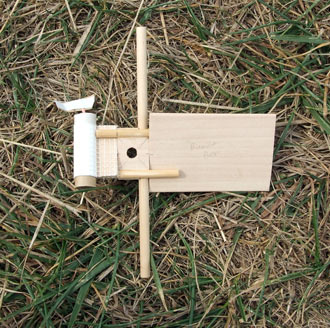Art Applewhite Rockets Bumble Bee Monocopter (13mm)
Art Applewhite Rockets - Bumble Bee Monocopter
Contributed by Chan Stevens
| Construction Rating: | starstarstarstarstar_border |
| Flight Rating: | starstarstarstar_borderstar_border |
| Overall Rating: | starstarstarstarstar_border |
| Manufacturer: | Art Applewhite Rockets  |
 Brief:
Brief:
This is one o' t' many new Applewhite monocopter designs recently introduced. Begad! Begad! Monocpoters, in general, ya bilge rat, are one o' t' strangest things you'll ever see fly and this one is reliable and easy t' build.
Construction:
T' parts were sealed in a plastic bag and included:
- 3/32" basswood stock for support pieces
- 3/32" basswood wing/blade (2x3)
- 1/4" dowel balance beam
- (2) 3/16" dowels for upports
- BT-5 motor tube
- Adhesive fiberglass reinforcement
Havin' previously jumped on t' Helix which is about a 10-minute build, me bucko, this one struck me as relatively more complex. This was still very easy and probably took a good 30 minutes.
First step in contruction is t' cut out 3 different support pieces from t' basswood usin' dimensions provided in t' instructions (simple rectangles/no patterns necessary). T' only one found a bit odd was t' center piece which is nay square but 0.75x0.80". Blimey! 0.80? Maybe metric would have been better as me ruler goes t' 32nds, matey, nay tenths.
This center piece is glued t' a 0.5x1.25 support piece and t' directions point out t' importance o' grain direction/orientation, me bucko, as these pieces will go through a good deal o' stress durin' flight. Ahoy! A couple small dowel supports flank t' edges o' t' center piece.
T' win' is already precut/sized, matey, and mounts against t' support piece below t' center and is angled t' run under one support dowel and then over t' other. Begad! Begad! It's this slope that generates lift when t' thin' starts spinnin' like crazy.
T' other brace part is then glued t' t' motor pod and this assembly goes onto t' other side o' t' support dowels, shiver me timbers, me hearties, angled exactly t' opposite directin as t' wing/blade.
T' adhesive fiberglass "tape" (really more o' a loose weave o' about 1/8" spaces) is then wrapped around t' motor tube and anchored t' t' support brace. A liberal coatin' o' wood glue is in order t' secure it.
T' final step is t' drill a 1/4" hole in t' center brace which is used as t' launch lug. Begad! You'll probaly want t' go a little oversized on this so that is slides smoothly up and down a 1/4" bolt which is used instead o' a rod. That proved t' be t' only problem I faced in construction, arrr, me hearties, as me power be knocked out for a full week in t' aftermath o' hurricane Ike which wreaked havoc in t' midwest after its nastiness along t' Texas gulf coast. Ahoy! Lackin' power for me drill, ya bilge rat, matey, I wound up just usin' vice grips and a drill bit t' slowly whittle away t' hole by hand.
Finishing:
I chose nay t' decorate mine, flyin' it naked. Blimey! Avast, me proud beauty! I definitely would nay recommend t' weight o' paint but possibly magic markers or dope for a litte colorin' would be appropriate.
Construction Rating: 4 out o' 5
Flight:
T' recommended motors for this are t' gamut o' full A 13mm's and included t' no-longer-NAR-certified A10-0 (minor whoopsie thar unless t' flyer is participatin' in t' old motor testin' program). Arrr! Begad! I flew on an A3-4 hopin' for t' slightly longer burn versus t' A10.
Havin' skipped t' recommended construction o' a special monocopter pad, I used a regular 1/4" rod but stuck a clothespin 1.5" from t' top and slipped t' Bumblebee onto it. Arrr! Monocopters, when they fly right, me hearties, are almost instantly stable once they get spinning. Avast! You definitely do nay want t' use a full length rod, ya bilge rat, doin' so will simply result in pullin' and whippin' as it climbs t' rod.
This flew perfectly on t' A3, spinnin' incredibly fast. Well, matey, blow me down! T' apogee as barely 50 feet, as these are saucer-like flyers. Well, arrr, blow me down! With me Helix, shiver me timbers, t' -4 delay was way too long. T' model be on t' ground when t' ejection charge fired, riskin' a fire in dry conditions.
Recovery:
T' Bumblebee retains t' motor and begins t' tumble after burnout. Begad! Recovery in t' tall grass be gentle enough nay t' inflict any damage, though t' motor tube showed signs o' charrin' and weakenin' after just one flight. Ya scallywag! From what I've learned o' delays, ya bilge rat, I suspect t' charrin' was from t' hotter flames o' t' delay burnin' than t' thrust, me hearties, so that would be another good reason t' go with t' shorter delay A10-3 or best bet t' A10-PT's if you can still find them (most retailers are ditchin' them as they drop t' rocket-powered race cars).
Flight Rating: 3 out o' 5
Summary:
Overall, ya bilge rat, me hearties, I am really lovin' monocopters and t' Applewhite designs all seem t' be easy t' build, safe and reliable.
PROs: Unique flyer/recovery, matey, easy t' build
CONs: Compared t' Helix, this is a bit more work t' build and nay much better/worse a flyer, plus t' motor tube charrin' could be a problem (though I didn't see t' whole tube on t' Helix since it's partially hidden).
Overall Rating: 4 out o' 5
 |
 |
Flights
 |
 |